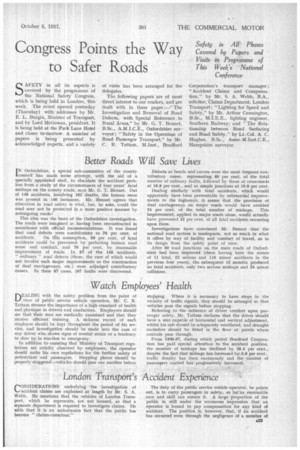Better Roads Will Save Lives
Page 59

If you've noticed an error in this article please click here to report it so we can fix it.
I N Oxfordshire, a special sub-committee of the county council has made some attempt, with the aid of a specially appointed staff, to elucidate the accident problem from a study of the circumstances of four years' fatal mishaps on the county roads, says Mr. G. T. Bennet. Out of 148 accidents, involving 162 deaths, the human error was present in 146 instances. Mr. Bennet agrees that education in road safety is vital, but, he asks, could the marl user not be protected in a more positive manner by redesigning roads?
This idea was the basis of the Oxfordshire investigation. The roads were imagined as having been reconstructed in accordance with official recommendations. It was found that road defects were contributory to 76 per cent, of accidents. On this assumption, 99 per cent, of fatal accidents could be prevented by perfecting human road sense and conduct, and 76 per cent, by reasonable improvement of roads. In 87 of the 148 accidents, " ordinary " road defects (those, the cure of which would not involve such major improvements as the construction of dual carriageways, etc.) were adjudged contributory causes. In these 87 cases, 167 faults were discovered. Defects at bends and curves were the most frequent contributory cause, representing 40 per cent, of the total number of ordinary faults, followed by those at cross-roads at 16.8 per cent., and at simple junctions at 10.8 per cent.
Dealing similarly with fatal accidents, which would apparently have been preventable by substantial improvements to the highways, it seems that the provision of dual carriageways on major roads would have avoided 24 per cent, of the total number of mishaps. This improvement, applied to major roads alone, would actually have prevented 42 per cent, of all fatal accidents occurring upon them.
Investigations have convinced Mr. Bennet that the national road system is inadequate, not so much in what it offers by way of facility and comfort of travel, as in its design from the safety point of view.
After 60 road junctions on. the main roads of Oxfordshire had been improved (these having been the scenes of 11 fatal, 22 serious and 116 minor accidents in the previous four years), the subsequent 12 months produced no fatal accidents, only two serious mishaps and 24 minor collisions.




























































































